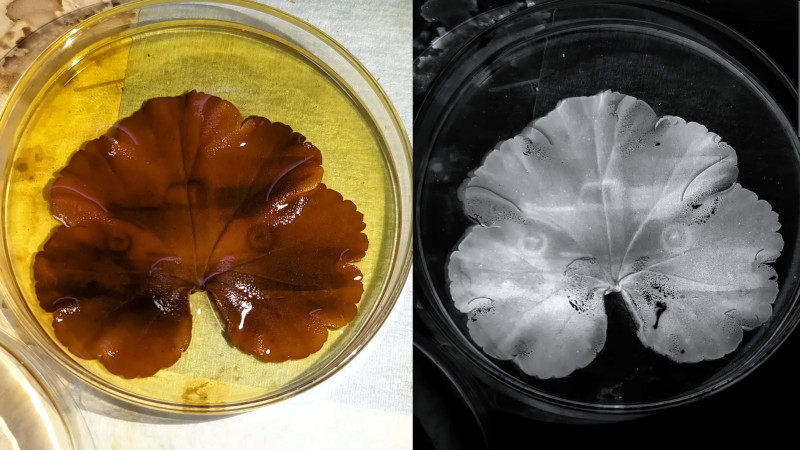Something that haunts film photographers is the prospect of a film shortage. This won’t replace film in that event, but [Applied Science] demonstrates photography using leaves. That’s right, a plant can record an image on its leaves.
Anyone with a high-school level of education can tell you that the leaf is a solar energy harvester, with the green chlorophyll using CO2 scavenged from the air to make sugars in the presence of light. It stands to reason that this light sensitivity could be used to capture images, and indeed if you place a leaf in the dark for an extended period of time its chlorophyll fades away where there is no light. The technique described in the video below the break is different though, and much more sensitive than the days-long exposures required to strip chlorophyll. It relies on starch, which the leaf uses to store energy locally when it has an excess of light.
First the starch is depleted by keeping the leaf in the dark, but not long enough to strip the chlorophyll. An image is then exposed on the leaf, and developed by removing the chlorophyll with alcohol and staining the starch with iodine. Merely saying that an image is exposed doesn’t convey that this is hardly a sensitive process though. Exposures take hours in sunlight, with simple masks, with 35 mm negatives, and then with a huge home made lens, a shadowy picture of a pickup truck. We are guessing that if geranium leaves had an ISO number, it would be a tiny fraction of a point.
On one hand this is barely a functional photography medium, while on the other we’re sure that it will be of great interest to artists and other creative people. Where we’re fascinated though is in the choice of leaf. There must be species with more chlorophyll than a geranium, and we wonder how much help some selective plant breeding for starch production could be.
Meanwhile if your taste in photographic chemistry stays with silver halides, we’ve taken you to a film factory before.
















following the trailer link: Colin Furze made the first digital camera!
At home we do something similar with the kids, called Anthotypes.
Put a bag of spinach in a blender, then squeeze the mash into a cloth to extract the juice. Coat a piece of paper with the green juice. Put the coated paper in the sunlight and place random objects on top to create a mask (eg arrange random bits into the shape of a robot). After a few hr, the sun will bleach the spinach juice, except where it was masked.
Here it a a cool robot we made. The mask is heat sinks, ball bearings, beam motor mounts, fan cover etc.
https://pasteboard.co/jLzB4Oa3MSZ8.jpg
Geraniums were chosen because of their fragility, not their chlorophyll content.
The process of developing the image requires leaves with a structure that allows removal of the chlorophyll quickly while keeping the starch in place. The same goes for the iodine wash.
Hi , just a note on lens design. The f number can only be calculated from the diameter of the front element if all the light from the front element enters the rear element. Assuming your subject is far off this will imply a fixed distance between the two and therefore a specific field of view. If you meddle with the lens separation to get a preferred FOV then your lens will have a lower “speed”. I am sure you knew this and just left it out to keep the audio description more concise.